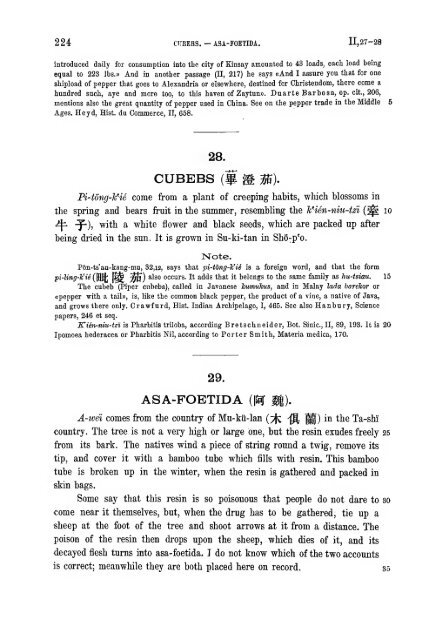Chau Ju-Kua - University of Oregon Libraries
Chau Ju-Kua - University of Oregon Libraries
Chau Ju-Kua - University of Oregon Libraries
You also want an ePaper? Increase the reach of your titles
YUMPU automatically turns print PDFs into web optimized ePapers that Google loves.
224 CIIBEBS. — ASA-FOETIDA. 11,27-28<br />
introduced daily for consumption into the city <strong>of</strong> Kinsay amounted to 43 loads, each load being<br />
equal to 223 lbs.» And in another passage (II, 217) he says «And I assure you that for one<br />
shipload <strong>of</strong> pepper that goes to Alexandria or elsewhere, destined for Christendom, there come a<br />
hundred such, aye and more too, to this haven <strong>of</strong> Zaytun». Duarte Barbosa, op. cit, 206,<br />
mentions also the great quantity <strong>of</strong> pepper used in China. See on the pepper trade in the Middle<br />
Ages, Heyd, Hist, du Commerce, II, 658.<br />
28.<br />
CUBEBS ($. m »<br />
Pi-tong-kHe come from a plant <strong>of</strong> creeping habits, which blossoms in<br />
the spring and bears fruit in the summer, resembling the hHm-niu-tzi (^ lo<br />
^ y*), with a white flower and black seeds, which are packed up after<br />
being dried in the sun. It is grown in Su-ki-tan in Sho^p'o.<br />
Note.<br />
Pon-ts'au-kang-mu, 32,i2, says that pi-tonff-h'ie is a foreign word, and that the form<br />
pi-ling-h'ie (^j^ ) also occurs. It [^ ^Jj<br />
adds that it belongs to the same family as hu-isiau. 15<br />
The cubeb (Piper cubeba), called in Javanese liurmikus, and in Malay lada barekor or<br />
«pepper with a tails, is, like the common black pepper, the product <strong>of</strong> a vine, a native <strong>of</strong> Java,<br />
and grows there only. Crawfurd, Hist. Indian Archipelago, I, 465. See also Hanbury, Science<br />
papers, 246 et seq.<br />
E'ien-niu-tz'i is Pharbitis triloba, according Bretschneider, Bot. Sinic, II, 89, 193. It is 20<br />
Ipomoea hederacea or Pharbitis Nil, according to Porter Smith, Materia medica, 170.<br />
29.<br />
ASA-FOETIDA (psf M)-<br />
A-wei comes from the country <strong>of</strong> Mu-kii-lan (^j^ ^ M)<br />
^'^ *^^ Ta-shi<br />
country. The tree is not a very high or large one, but the resin exudes freely 25<br />
from its bark. The natives wind a piece <strong>of</strong> string round a twig, remove its<br />
tip, and cover it with a bamboo tube which fills with resin. This bamboo<br />
tube is broken up in the winter, when the resin is gathered and packed in<br />
skin bags.<br />
Some say that this resin is so poisonous that people do not dare to 30<br />
come near it themselves, but, when the drug has to be gathered, tie up a<br />
sheep at the foot <strong>of</strong> the tree and shoot arrows at it from a distance. The<br />
poison <strong>of</strong> the resin then drops upon the sheep, which dies <strong>of</strong> it, and its<br />
decayed flesh turns into asa-foetida. T do not know which <strong>of</strong> the two accounts<br />
is correct; meanwhile they are both placed here on record. 35

















